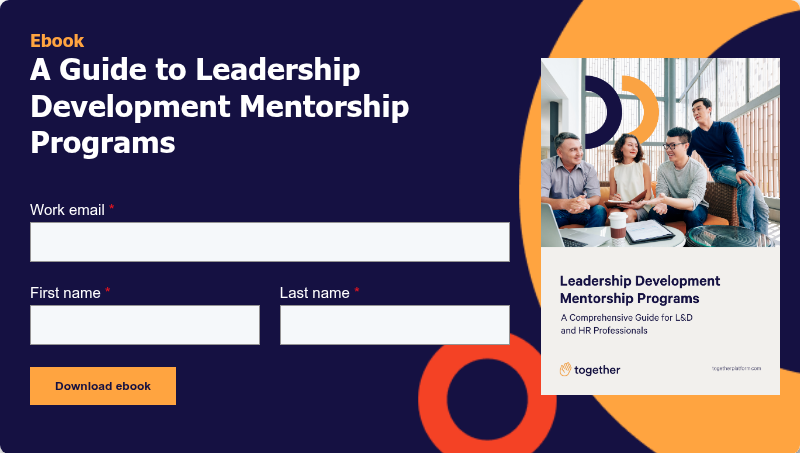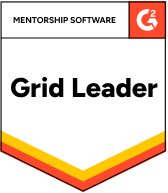Nearly half of managers (45%) say their organization isn’t doing enough to cultivate future leaders, with leadership training often flagged as the most neglected component of development initiatives. That gap puts succession planning at risk and leaves organizations scrambling to build the leadership pipeline they need.
Mentoring is one of the most effective ways to address this challenge. Leadership mentoring programs give rising talent access to senior guidance, fosters resilience, and prepares employees for future roles. Instead of leaving early- and mid-career talent to find support on their own, organizations can intentionally invest in high-potential employees and turn them into confident, capable leaders.
There’s no single “right way” to design a leadership mentoring program. Some companies take a broad approach, while others tailor mentoring to specific groups, often aligning efforts with diversity, equity, and inclusion initiatives such as employee resource groups (ERGs).
To help you see what’s possible, we’ve compiled 13 real-world examples of leadership mentoring done right. These programs show how organizations are bridging pipeline gaps, strengthening internal leadership, and driving measurable value. Whether you’re just beginning your program or looking to optimize an existing program, these examples will give you inspiration to structure mentoring the right way.
1. Avison Young
When Avison Young looks to develop its next generation of leaders, it turns to its leadership mentorship program powered by Together. The program has paired thousands of mentors and mentees, fueling leadership development while advancing the company's DEI commitments.
Active involvement of Avison Young’s employee resource groups (Empower, Roots, Folx, Conexión, and Pangea) has made its mentoring programs wildly successful. Avison Young’s women’s network was the first to pilot mentorship internally, laying the groundwork for broader adoption.
Employees report that the program gives them direct access to senior leaders and bigger opportunities to demonstrate their skills. By involving its Board of Directors and Global Executive Committee in mentoring, Avison Young is creating a high-quality support system and a leadership pipeline designed for the future.
2. Sun Microsystems
What if mentoring could produce higher rates of promotions and retention in your organization? In a pivotal example of the power of leadership mentoring programs, Sun Microsystems sought to understand the value of mentoring at work. The results were striking: mentors and mentees were promoted at five to six times the rate of non-participants, and 25% saw salary increases compared to just 5% of their peers.
Sun’s mentoring program reached over 7,000 employees (nearly a third of its workforce) and became a cultural pillar for identifying and developing future leaders. By connecting employees across levels, geographies, and functions, the program gave rising talent direct exposure to senior leaders, helped them showcase their skills, and broke down organizational silos.
Sun Microsystems proved that mentoring delivers measurable results and builds the next generation of leaders. While Oracle has since acquired the company, the mentoring programs built there continue to shape how organizations think about leadership development.
3. New York Life
New York Life’s Empower Mentorship Program demonstrates how leadership mentoring can serve both emerging talent and established leaders. As part of its corporate responsibility strategy, the company emphasizes mentoring as a way to build an inclusive leadership pipeline. The Empower program connects employee resource group (ERG) members with senior leaders from across the organization, fostering professional growth, knowledge-sharing, and cross-functional connections.
With over 500 participants, the program has helped mentors refine their own coaching and leadership skills. Mentees gain insight into competencies like conflict resolution, influence, and career planning. New York Life has put energy into making its mentoring programs more varied. As a result, 53% of mentor-mentee pairings were between individuals from diverse backgrounds, which helps build trust and inclusive leadership skills. As one participant put it, working through real challenges with a mentor offered "a better understanding of how to use leadership skills to drive more effective influence."
4. Royal Bank of Canada
Royal Bank of Canada’s Leadership Development Program is a rotational experience that allows graduate-level talent to work across multiple business units while building leadership skills. Participants gain access to senior leaders and alumni mentors, ensuring that development is supported both formally and informally.
The program has produced strong results. Since the launch of RBC's leadership development program, nearly 400 associates have completed the program, and many have moved into senior leadership roles. Alumni now include executives, senior directors, and directors across the bank, a clear indication of the program's long-term impact.
Diversity has also been a central focus: recent cohorts have been majority women and BIPOC, making the program not just a leadership pipeline but a way to strengthen representation at higher levels of the company.
Sustained investment in leadership development pays off, and RBC has built a program that reliably produces leaders who can guide the organization into the future.
5. Louisiana Office of Public Health
The Louisiana Office of Public Health launched a mentorship program to address challenges like burnout, turnover, and succession planning. With nearly 30% of its workforce expected to retire within five years, the organization recognized the need to build leadership skills and strengthen employee connections.
The program was first proposed in 2019 and later expanded with Together’s mentorship software. Pairs were matched into six-month cohorts with structured agendas, reminders, and access to a speaker series on topics such as organizational culture and cross-generational leadership.
The program delivered impressive results. All participants rated the experience as valuable, and mentees gained measurable skill growth, moving from little to no knowledge to at least some proficiency in their chosen focus areas. Retention and eNPS improved, pointing to stronger loyalty and reduced turnover risk.
Quotes from participants emphasized reduced stress, improved job satisfaction, and fulfillment for mentors sharing their experiences. When people hear about mentorship programs, they assume they only work in startups or private companies, but the public sector needs great mentors. Institutional knowledge is key in industries like the government, so mentoring will ensure that future leaders have the skills they need to succeed.
6. Estée Lauder Companies
Estée Lauder uses a suite of mentorship programs deeply rooted in leadership development and diversity. Its Open Doors initiative, piloted in the supply chain department, delivers leadership learning via live sessions and self-guided modules, all backed by senior sponsorship.
The Women in Supply Chain ERG, comprising ~800 members across 31 locations, creates upward mobility and community for women across job levels. The company's commitment extends to reverse mentoring, pairing 350+ senior leaders with diverse employees, fostering mutual leadership learning.
7. Adobe
Adobe has built a strong culture of mentoring that supports employees on leadership tracks. The company emphasizes representation by creating programs that open leadership opportunities for women. Specifically, Adobe has created the Adobe & Women Leadership Council, which is a group of women who support internal initiatives like education, mentoring, and recruiting.
Beyond formal programs, Adobe fosters a grassroots mentoring culture. Adobe's design team has shared how mentoring relationships help employees sharpen leadership, communication, and collaboration skills. This approach positions mentorship not just as a tool for early-career employees, but as a way to prepare people across levels for future leadership roles.
Adobe’s strategy has also been recognized externally. Adobe’s mentoring programs have been heralded as a best-in-class example of how companies can embed leadership development into everyday practice, rather than leaving it as a one-off initiative.
8. Nielsen
Nielsen’s Emerging Leaders Program is a two-year rotational initiative for early-career associates across tracks like commercial, finance, HR, and tech. Participants gain executive mentors, peer networks, and high-impact project assignments that accelerate their readiness for leadership.
For mid-career talent, the Diverse Leadership Network functions like a mini-MBA, combining executive education, coaching, and stretch assignments. In 2024, graduates joined leadership courses at Emory University’s Goizueta Business School and delivered cross-functional projects that boosted both their visibility and leadership capacity.
By layering these programs, Nielsen shows how structured mentorship can develop future leaders at multiple career stages.
9. AT&T
AT&T has developed a range of mentoring programs to strengthen leadership and create career pathways for employees. The company’s Pathways to Success Mentoring Program pairs experienced leaders with early-career talent, focusing on skill-building and advancement opportunities that prepare employees for leadership roles. In addition, targeted efforts like the Call Center Mentorship Program help frontline employees develop confidence, grow into supervisory positions, and expand career horizons.
AT&T also emphasizes reverse mentoring, where executives learn directly from younger employees on topics like technology, culture, and evolving workplace expectations. Leaders say this approach not only builds stronger relationships but also helps executives stay agile and connected to employee needs. These programs support the company’s broader commitment to human capital management and investing in its workforce as a driver of long-term growth.
10. Coca-Cola
Coca-Cola integrates mentoring directly into its career development strategy, providing employees with coaching, networking, and leadership opportunities. At Coca-Cola Hellenic, employees describe mentoring as a way to gain perspective and confidence; one employee, Bata, noted that the program gave him both professional direction and personal growth.
These individual mentoring relationships are supported by larger organizational initiatives like the Leadership Training Lab, designed to equip managers with skills in innovation, decision-making, and people leadership.
11. Booz Allen Hamilton
Booz Allen Hamilton uses mentoring circles to connect junior employees with multiple senior mentors in a group setting. The program encourages open dialogue, shared learning, and stronger cross-level relationships, especially as the firm continues to grow. Mentorship is built into the company’s broader development strategy and tracked through its internal learning and development framework.
Employees also benefit from executive coaching, virtual campus tools, and new leader immersion programs designed to support career mobility and knowledge sharing. Senior leaders are expected to mentor as part of their role, helping reinforce culture and prepare the next generation of leadership.
12. Deloitte Luxembourg
Deloitte Luxembourg launched Women in/to Leadership on International Women’s Day to help women across service lines build leadership skills through mentorship, workshops, and networking. Participants benefit from mentor–mentee pairings, confidence-building sessions led by both internal and external experts, and both internal and community networking events that expand their influence and support networks.
During the 2024 fiscal year, WIL hosted six events, supported 160 active members, and established 22 mentor–mentee pairs, all designed to raise visibility and readiness for leadership roles within and beyond Deloitte.
13. GE
GE Aerospace runs the Experienced Commercial Leadership Program, a three-year initiative designed to prepare participants for commercial leadership roles. Through rotational assignments, executive mentoring, and a personalized development plan, participants build financial acumen, negotiation skills, and customer advocacy experience.
Each class of about ten rotates through locations such as Ohio, Singapore, London, Dubai, and China. The program also includes global exposure, career coaching, and community through events like Welcome Day and the Global Seminar, along with opportunities to contribute to ECLP committees.
Conclusion
Leadership mentoring programs address one of the most pressing challenges facing organizations today: the leadership pipeline gap. As the workforce changes and business challenges become more complex, companies cannot afford to leave leadership development to chance. Structured mentoring ensures rising talent gets the guidance, exposure, and confidence they need to step into bigger roles. It’s important to consider how you set up both mentors and mentees to be successful in this new workplace relationship.
The 13 examples we’ve explored highlight how organizations across industries have built systems that not only prepare their people but also strengthen retention, engagement, and culture.
There's no one-size-fits-all model. Some organizations prioritize mentoring future executives, while others focus on supporting women, minorities, or first-time managers. Successful programs are intentional, well-resourced, and aligned with broader organizational goals. By looking at real-world models, you can see how flexible mentoring can be, whether your focus is succession planning, DEI, or empowering the next generation of leaders.
If you’re ready to take the next step in designing or refining your own leadership mentoring program, we’ve put together an eBook that walks through everything from structuring relationships to measuring ROI. Download our Leadership Development Mentorship Programs eBook to get practical tools, templates, and deeper guidance to build a program that future-proofs your organization.



.svg)







.svg)

